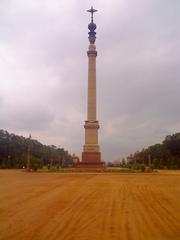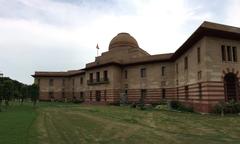Comprehensive Guide to Visiting Sabz Burj, Noida, India
Date: 24/07/2024
Introduction
Nestled in the bustling heart of New Delhi, Sabz Burj stands as an exquisite testament to the grandeur of Mughal architecture. Often referred to as the ‘Green Dome,’ this octagonal tomb is a captivating historical monument located near the Nizamuddin complex and adjacent to Humayun’s Tomb. Constructed in the early 1530s, Sabz Burj’s architectural features, such as its turquoise blue-tiled dome and intricate plaster patterns, make it a unique landmark among Delhi’s historic sites. Despite its early 20th-century misuse and deterioration, extensive restoration efforts from 2017 to 2021 have restored Sabz Burj to its former glory, unveiling remarkable aspects like the earliest surviving painted ceiling in India (Nizamuddin Renewal).
This comprehensive guide aims to provide visitors with all the essential information needed to explore Sabz Burj, including visiting hours, ticket details, and nearby attractions. Whether you are a history enthusiast or a casual traveler, Sabz Burj offers a unique and enriching glimpse into India’s rich heritage. The conservation project, spearheaded by the Aga Khan Trust for Culture (AKTC) in partnership with the Archaeological Survey of India (ASI), showcases a successful model of participatory conservation, respecting historic cities and their cultural assets (NDTV).
Table of Contents
- Introduction
- Historical Background
- Architectural Significance
- Early 20th Century Misuse and Deterioration
- Conservation Efforts (2017-2021)
- Visitor Information
- Nearby Attractions
- Special Events and Guided Tours
- Photographic Spots
- Current Status and Visitor Experience
- Future Prospects
- FAQ
- Conclusion
Historical Background
Sabz Burj, also known as the “Green Dome,” is an octagonal tomb situated on Mathura Road, near the Nizamuddin complex and adjacent to Humayun’s Tomb in New Delhi. The monument is one of the earliest Mughal-era structures in India, dating back to the 1530s. The identity of the nobleman for whom this mausoleum was built remains unknown, but it is speculated to have been constructed during the reign of Humayun. Some historians suggest that it might have been built for Fahim Khan, an attendant to Abdur Rahim Khan during the reign of the fourth Mughal emperor, Jahangir, who died in 1626 A.D. (Wikipedia).
Architectural Significance
The Sabz Burj stands out due to its unique architectural features, including its glazed tiles on the dome and the tall, elongated drum on which the dome rests. The monument’s octagonal structure is adorned with intricate incised plaster patterns on each of its eight facades. These patterns include geometric and floral designs, as well as inscriptions created in incised lime plaster. The dome itself is covered with turquoise blue tiles, while the drum features a repetitive pattern of lapis blue and turquoise tiles (Nizamuddin Renewal).
Early 20th Century Misuse and Deterioration
In the early 20th century, Sabz Burj was repurposed as a police station, leading to significant misuse and deterioration. The painted interiors were plastered over, and much of the incised plaster decoration on the façade was lost and replaced with cement layers. By the 1980s, much of the original tile work on the dome had fallen away and was re-tiled with modern tiles fixed with cement mortar. This led to severe structural deterioration and water seepage issues (Nizamuddin Renewal).
Conservation Efforts (2017-2021)
Initial Steps
The conservation of Sabz Burj began in earnest in 2017, spearheaded by the Aga Khan Trust for Culture (AKTC) in partnership with the Archaeological Survey of India (ASI). The project was supported by Havells and aimed to restore the monument to its former glory using traditional materials and building craft techniques favored by 16th-century craftsmen. The initial steps included archival research, architectural documentation, and a structural and condition assessment of the building (Nizamuddin Renewal).
Restoration of Tiles and Plaster Patterns
One of the most significant aspects of the restoration was the removal of 20th-century cement from the dome and walls. This was replaced with lime plaster to protect the structure from further decay. The dome was exposed for several months to allow the dampness to dry out before restoring tiles that matched the original 16th-century tiles. All surviving original tiles were retained, even if they had lost their glaze. Missing tiles on the drum were restored, and the roof and terrace were relaid with lime concrete to their original levels and slopes to prevent rainwater ingress (NDTV).
Discovery of Painted Ceiling
During the conservation efforts, a significant discovery was made - a painted ceiling adorned with pure gold and lapis lazuli, among other elements. This ceiling is now considered the earliest surviving painted ceiling for any monument in India. The intricate painting was painstakingly revealed by specialist conservators after the removal of cement and tiles from the 1986 restoration. This discovery highlighted the monument’s historical and cultural significance (India Today).
Use of Traditional Craftsmanship
The restoration project employed master craftsmen, including stone carvers, masons, and tile makers, who used traditional materials and techniques. This approach ensured the authenticity of the material, form, and design while retaining the monument’s integrity for future generations. The conservation effort also included the restoration of the decorative plaster patterns on all eight sides of the façade, based on surviving fragments of the original patterns (Nizamuddin Renewal).
Visitor Information
Visiting Hours
Sabz Burj is open to visitors daily from 10:00 AM to 6:00 PM. It is advisable to check the official website or contact the Archaeological Survey of India for any updates on visiting hours.
Tickets
Entry to Sabz Burj is free of charge, making it an accessible attraction for all visitors. However, donations for the upkeep and maintenance of the monument are always welcome.
How to Get There
Sabz Burj is conveniently located near Humayun’s Tomb in New Delhi. Visitors can reach the site by metro, with the nearest station being JLN Stadium on the Violet Line. It is also well-connected by local buses and auto-rickshaws.
Nearby Attractions
While visiting Sabz Burj, make sure to explore other nearby historical sites, including Humayun’s Tomb, Nizamuddin Dargah, and the Isa Khan’s Tomb. These attractions offer a deeper insight into the rich history and architectural heritage of the Mughal era.
Special Events and Guided Tours
Sabz Burj occasionally hosts special events and guided tours organized by the ASI and other cultural organizations. These tours provide an in-depth understanding of the monument’s history and restoration efforts. Check the official ASI website for upcoming events and tour schedules.
Photographic Spots
The newly restored Sabz Burj, with its gleaming blue-tiled dome, offers numerous photographic opportunities. The intricate plaster patterns, the octagonal structure, and the beautifully restored dome make for stunning photographs. Early morning or late afternoon light provides the best conditions for photography.
Current Status and Visitor Experience
As of 2021, the conservation of Sabz Burj has been completed, and the monument now stands as a testament to the rich architectural heritage of the Mughal era. The newly renovated Sabz Burj, with its gleaming blue-tiled dome, catches the eye from a distance and offers a unique sensory experience for visitors. The monument is now protected by the ASI and stands prominently at the entrance to the Humayun’s Tomb World Heritage Site, attracting over 6 million visitors annually (Nizamuddin Renewal).
Future Prospects
The successful conservation of Sabz Burj serves as an archetype for participatory conservation-led development, respecting historic cities and their cultural and physical assets. The project showcases a unique and effective approach to the revitalization of historic urban centers by simultaneously focusing on the conservation of protected and unprotected monuments and public space enhancement (Nizamuddin Renewal).
FAQ
Q: What are the visiting hours for Sabz Burj?
A: Sabz Burj is open daily from 10:00 AM to 6:00 PM.
Q: Is there an entry fee for Sabz Burj?
A: No, entry is free of charge.
Q: How can I reach Sabz Burj?
A: The monument is near Humayun’s Tomb in New Delhi, accessible by metro (JLN Stadium station), local buses, and auto-rickshaws.
Q: Are there guided tours available?
A: Yes, guided tours are occasionally organized by the ASI and other cultural organizations. Check the ASI website for schedules.
Conclusion
In summary, the history and restoration efforts of Sabz Burj highlight the monument’s architectural significance and the meticulous work undertaken to preserve its cultural heritage. The conservation project not only restored the monument’s original splendor but also uncovered significant historical elements, making Sabz Burj a must-visit site for history enthusiasts and tourists alike. Don’t miss the opportunity to explore this remarkable piece of history during your visit to New Delhi. For more updates, download the Audiala mobile app, check out other related posts, and follow us on social media.

